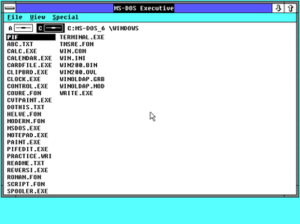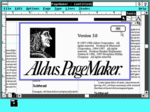
The Intel 80286 is a 16-bit microprocessor that was introduced on February 1, 1982. It was the first 8086-based CPU with separate, non-multiplexed address and data buses and also the first with memory management and wide protection abilities. The 80286 used approximately 134,000 transistors in its original nMOS (HMOS) incarnation and, just like the contemporary 80186, it could correctly execute most software written for the earlier Intel 8086 and 8088 processors.

Xenix is a discontinued version of the Unix operating system for various microcomputer platforms, licensed by Microsoft from AT&T Corporation in the late 1970s. The Santa Cruz Operation (SCO) later acquired exclusive rights to the software, and eventually replaced it with SCO UNIX.

The Lattice C Compiler was released in June 1982 by Lifeboat Associates and was the first C compiler for the IBM Personal Computer. The compiler sold for $500 and would run on PC DOS or MS-DOS. The first hardware requirements were given as 96KB of RAM and one floppy drives. It was ported to many other platforms, such as mainframes (MVS), minicomputers (VMS), workstations (UNIX), OS/2, the Commodore Amiga, Atari ST and the Sinclair QL.
DataFlex is an object-oriented high-level programming language and a fourth generation visual tool for developing Windows, web and mobile software applications on one framework-based platform. It was introduced and developed by Data Access Corporation beginning in 1982.
The Microsoft Macro Assembler (MASM) is an x86 assembler that uses the Intel syntax for MS-DOS and Microsoft Windows. Beginning with MASM 8.0, there are two versions of the assembler: One for 16-bit & 32-bit assembly sources, and another (ML64) for 64-bit sources only.
Merge is a software system which allows a user to run DOS/Windows 3.1 on SCO UNIX, in an 8086 virtual machine.
LOADALL is the common name for two different, undocumented machine instructions of Intel 80286 and Intel 80386 processors, which allow access to areas of the internal processor state that are normally outside of the IA-32 API scope, like descriptor cache registers. The LOADALL for 286 processors is encoded 0Fh 05h, while the LOADALL for 386 processors is 0Fh 07h.
Meeting Maker is a cross-platform personal calendar and group scheduling software application from PeopleCube. First released in 1991 for Macintosh by ON Technology, support for other platforms followed in 1993 with Meeting Maker XP. Alongside Windows and Mac, native clients were released for OS/2 and Solaris, and later also for other platforms. Some support was also introduced for mobile platforms like Apple Newton, PalmPilot and Windows CE. Although powerful, its user interface - aiming at uniformity across multiple platforms — was criticized as weak and not supporting all features of target platforms.
Aldus PhotoStyler was a graphics software program developed by the Taiwanese company Ulead. Released in June 1991 as the first 24 bit image editor for Windows, it was bought the same year by the Aldus Prepress group. Its main competition was Adobe Photoshop. Version 2.0 introduced a new user interface and improved color calibration. PhotoStyler SE - lacking some features of the version 2.0 - was bundled with scanners like HP ScanJet. The product disappeared from the Adobe product line after Adobe acquired Aldus in 1994.
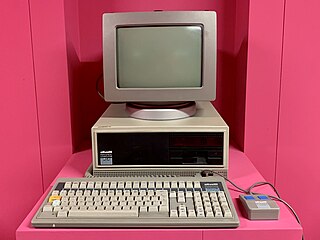
The Olivetti M24 is a computer that was sold by Olivetti in 1983 using the Intel 8086 CPU.
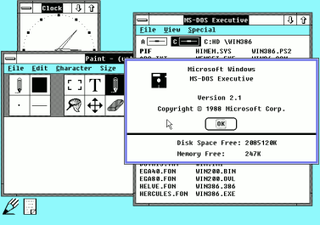
Windows 2.1 is a major release of Microsoft Windows. It was released to manufacturing on May 27, 1988, as a successor to Windows 2.0.
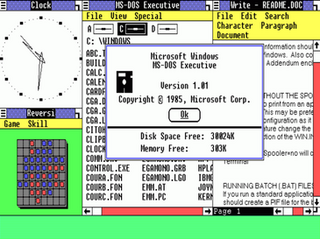
Windows 1.0 is the first major release of Microsoft Windows, a family of graphical operating systems for personal computers developed by Microsoft. It was first released to manufacturing in the United States on November 20, 1985, while the European version was released as Windows 1.02 in May 1986.

Windows 3.1 is a major release of Microsoft Windows. It was released to manufacturing on April 6, 1992, as a successor to Windows 3.0.

Windows 3.0 is the third major release of Microsoft Windows, launched in 1990. It features a new graphical user interface (GUI) where applications are represented as clickable icons, as opposed to the list of file names seen in its predecessors. Later updates would expand the software's capabilities, one of which added multimedia support for sound recording and playback, as well as support for CD-ROMs.
The Zinc Application Framework is an application framework, intended for the development of cross-platform software applications with graphical user interface (GUI), using a widget toolkit. Zinc targets both embedded and desktop platforms.

Chuck Colby was an electronics engineer and chief-inventor, founder and president of Colby Systems Corporation, a company that created the first DVR-based video surveillance systems but is also very notable as a pioneer in portable computing, being the first to market both DOS and Macintosh portable computers, as well as a remarkable number of other technological firsts.
PerfectDisk is a defragmentation software product for Windows developed by Raxco.

The Olivetti M20 is a Zilog Z8000 based computer designed and released by Olivetti in 1982. Although it offered good performance, it suffered from a lack of software due to its use of the Z8000 processor and custom operating system, PCOS. The company introduced the IBM PC compatible Olivetti M24 in 1983 and the M20 line was phased out.

The IBM ThinkPad 365 is a notebook computer series developed by IBM and manufactured by ASE Group. It was released in North America in November 1995, and was the successor of the ThinkPad 360 series. The series had 8 models that were released before being discontinued, and was succeeded in 1997 by the ThinkPad 380 series.

The IBM ThinkPad 700 is the first notebook computer for the ThinkPad brand that was released by IBM on October 5, 1992. Another series was released alongside it, the ThinkPad 300 series. The 300 series was meant to be a cheaper, lower performance model line over the 700. It was developed as a successor to the L40SX.
